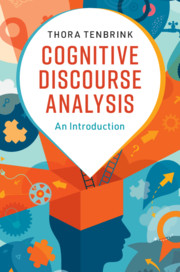Book contents
- Cognitive Discourse Analysis
- Cognitive Discourse Analysis
- Copyright page
- Contents
- Figures
- Tables
- Preface
- Acknowledgements
- Introduction
- 1 Background and Scope
- 2 Language as a Representation of Thought
- 3 Resources
- 4 Identifying Cognitive Orientation
- 5 Identifying Cognitive Depth
- 6 Identifying Cognitive Constructiveness
- 7 Using Language to Convey Thoughts
- 8 CODA Procedures
- 9 Beyond CODA
- Register of Linguistic Features
- References
- Index
7 - Using Language to Convey Thoughts
Published online by Cambridge University Press: 23 January 2020
- Cognitive Discourse Analysis
- Cognitive Discourse Analysis
- Copyright page
- Contents
- Figures
- Tables
- Preface
- Acknowledgements
- Introduction
- 1 Background and Scope
- 2 Language as a Representation of Thought
- 3 Resources
- 4 Identifying Cognitive Orientation
- 5 Identifying Cognitive Depth
- 6 Identifying Cognitive Constructiveness
- 7 Using Language to Convey Thoughts
- 8 CODA Procedures
- 9 Beyond CODA
- Register of Linguistic Features
- References
- Index
Summary
Chapter 7 addresses the formulation of thought from two perspectives. On the one hand, whenever we put thoughts into words, we do this for a specific purpose – typically for the benefit of an interaction partner. The first half of Chapter 7 discusses communication and dialogic interaction, where thoughts are formulated for an addressee; this affects how words are chosen, what kind of background knowledge is presumed, what style of language is adopted, etc.; also, speakers adapt to each other in the course of a dialogue. Further, dialogues follow specific structures that can be systematically accounted for. The second half of this chapter addresses the idea of cognitive strategies, which are the main target of think–aloud protocol analysis in traditional problem-solving studies. These are not intended to be primarily formulated for an addressee but instead represent the structure of cognitive processes in temporal sequence. While content analysis is the first (and often the only) crucial step for researchers in this general field, the chapter explores what kinds of insights CODA adds with its focus on linguistic features. This concludes the set of chapters addressing analysis perspectives.
Keywords
- Type
- Chapter
- Information
- Cognitive Discourse AnalysisAn Introduction, pp. 168 - 193Publisher: Cambridge University PressPrint publication year: 2020



